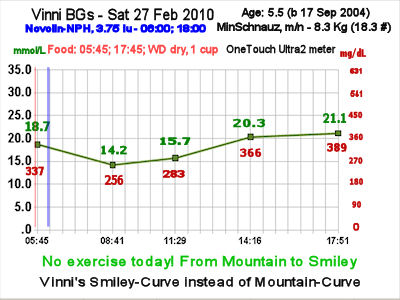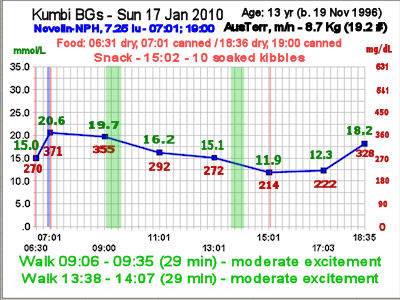Last updated: Thu, 4 Mar 2010 01:20:27
It is now Sun, 19 Sep 2010 06:37:19
Last updated: Thu, 4 Mar 2010 01:20:27
It is now Sun, 19 Sep 2010 06:37:19

[cvt30207cd-100227d12c.jpg] Vinni BG curve, 27 Feb 2010
This curve was Vinni's first Smiley Curve, and it certainly did startle his Human DogMum, Branka.
Branka has kindly permitted me to use her name, along with Vinni's data. Thanks, Branka.
Vinni's smile is slightly one-sided. It's interesting to compare with Kumbi's also one-sided smile.
At risk of pushing this metaphor a bit too far (since when did THAT stop me?), Vinni and Kumbi smile out of opposite sides. Or, maybe, Vinni smiles in the morning, and Kumbi smiles in the afternoon.
Although this wasn't a full curve, with readings every two hours, Branka has four previous curves to compare with, so she has records of Vinni's trends in glucose-level behavior. Vinni has tended to be very stable with levels; with no very sudden drops nor rises. That fact makes this incomplete curve meaningful and useful, because Branka can estimate that there aren't any surprises between readings.

[ckt20206cd-100117c06c] Kumbi's Smiley curve, 17 Jan 2010
Kumbi has often had Mountain Curves, but since I began giving him a tiny snack in mid-afternoon, his curves have occasionally been Smiley rather than Mountain.
As you can see, Kumbi's Smiley-curve is a bit one-sided, with higher numbers in the morning, and simply turning up a bit from the mid-afternoon low, in the evening, just before his supper.
Kumbi and I really depend on getting out for walks twice a day, to help keep his glucose levels down. However, Kumbi's insulin-peak time - the time the insulin is working most strongly, has varied from about three in the afternoon to very shortly before his supper-time.
Three in the afternoon is usually the best time to take him out walking, considering neighborhood conditions, and THAT is the time one must exercise (any pun intended) caution. It doesn't do to indulge in activity likely to drop glucose levels a lot, at the same time the insulin is peaking.
Giving a little snack, perhaps with a combination of carbohydrates and some protein, can prevent too fast a drop in glucose levels that could result, say, if sudden excitements during a walk were to bring on a body-demand for a surge of glucose.
How much and what kind of snack to give could vary; the snack should be well-adjusted to the dog's diet to begin with. The goal with a snack is to keep glucose levels from going TOO far down all at once. At the same time, we don't want to shoot the levels up too far!
Kwali contributed to this snack-plan for Kumbi, because SHE needed a mid-afternoon snack. And what one of my dogs gets, the other gets, too - in some way, at least.
I should note that for the first four months after Kumbi was diagnosed with diabetes (on 1 Sept 2006), I fed him nothing at all between his two meals. He had only breakfast and supper, twelve hours apart.
Until the insulin dose and food are well-adjusted to work together, feeding treats or snacks can confuse things, and make the insulin-dose adjustment very difficult. So, it's commonly recommended, immediately after diagnosis, to avoid any extra food between the two meals of the day.
Poor Kwali had the same, though sometimes I took her aside, well away from Kumbi, and fed her a midday meal, because she really needed that.
Once a semblance of regulation is achieved, it becomes possible to add limited treats and snacks. With diabetic dogs, we always need to be attentive to their diets, as well as to the insulin dose. Food and insulin work together.


